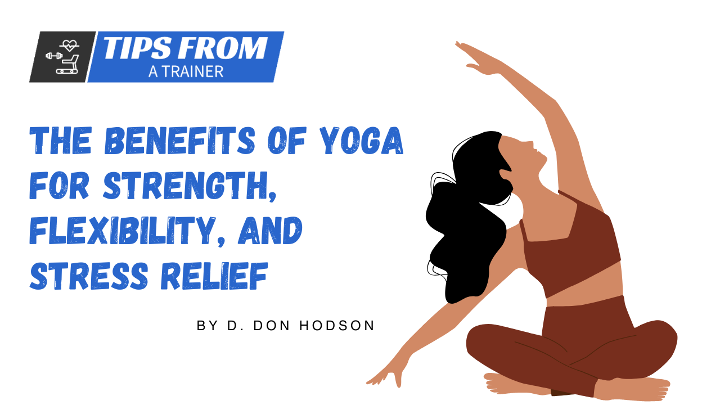Introduction
The Multifaceted Nature of Yoga
Yoga, an ancient practice with roots in India, is a holistic approach to well-being that encompasses not only physical aspects but also mental and emotional dimensions. Unlike many modern exercise routines that focus solely on building strength or flexibility, yoga offers a comprehensive and integrated approach to enhancing various facets of health. By engaging both body and mind, yoga transcends mere physical exercise, promoting a sense of harmony and balance that extends far beyond the yoga mat.
Holistic Approach to Well-being
The essence of yoga lies in its recognition of the interconnectedness between the body, mind, and spirit. It goes beyond the confines of physical exertion to address the broader aspects of human existence. This ancient practice acknowledges that optimal health cannot be achieved by isolating individual components of well-being; rather, it requires a holistic and unified approach. Yoga fosters a sense of equilibrium, inviting practitioners to cultivate a harmonious relationship between the physical body and the mental and emotional realms.
Purpose of the Article
The purpose of this article is to delve into the multifaceted benefits of yoga, focusing on its profound contributions to strength, flexibility, and stress relief. By exploring the scientific foundations of these benefits and examining various yoga styles, we aim to provide readers with a comprehensive understanding of how yoga can serve as a powerful tool for nurturing overall well-being. Through this exploration, individuals can gain insights into how to harness the potential of yoga to unlock physical vitality, mental clarity, and emotional serenity.
Table of Contents
Introduction
The Multifaceted Nature of Yoga
Holistic Approach to Well-being
Purpose of the Article
Yoga: A Blend of Strength and Flexibility
Building Functional Strength
Enhancing Flexibility and Range of Motion
Balancing Strength and Flexibility for Optimal Health
Stress Relief Through Mind-Body Connection
Mindfulness and Stress Reduction
Regulation of the Stress Response
Cultivating Emotional Resilience
Yoga Styles for Strength, Flexibility, and Stress Relief
Hatha Yoga: Foundation of All Styles
Vinyasa Flow: Dynamic Strength and Flexibility
Restorative Yoga: Deep Relaxation and Stress Relief
The Science Behind Yoga's Benefits
Neurological Effects: Brain Plasticity and Relaxation Response
Hormonal Regulation: Cortisol and Endorphins
Physical Adaptations: Muscles, Connective Tissues, and Posture
Incorporating Yoga into Your Routine
Yoga for All Fitness Levels
Tailoring Yoga to Your Goals
Integrating Yoga with Other Exercise Modalities
Practical Tips for a Fulfilling Yoga Practice
Finding the Right Instructor or Class
Creating a Sacred Space for Practice
Consistency and Mindful Progression
Conclusion
Embracing Yoga as a Path to Holistic Well-being
Unlocking Strength, Flexibility, and Serenity through Yoga

Yoga: A Blend of Strength and Flexibility
Building Functional Strength
Yoga is not merely about lifting weights or performing repetitive motions; instead, it emphasizes functional strength that supports daily activities and enhances quality of life. Yoga asanas involve isometric contractions, bodyweight resistance, and controlled movements that engage multiple muscle groups simultaneously. This comprehensive approach not only strengthens the major muscle groups but also targets stabilizing muscles, promoting balanced muscle development and reducing the risk of muscular imbalances and injuries.
Through yoga, individuals can develop a strong and capable body that is better equipped to handle the demands of daily tasks. Asanas such as Plank, Chaturanga Dandasana, and Warrior Poses engage the core, shoulders, arms, and legs, fostering a well-rounded and functional form of strength that extends beyond the confines of the yoga mat.
Enhancing Flexibility and Range of Motion
While many exercise modalities prioritize muscle contraction and hypertrophy, yoga places equal emphasis on elongating and stretching muscles and connective tissues. Flexibility is not just about touching your toes; it's about optimizing joint mobility and range of motion. Yoga encourages gradual and controlled stretching, which helps release tension in muscles and connective tissues while enhancing joint flexibility.
Through consistent practice, yoga postures gently lengthen and release muscles, tendons, and ligaments. This gradual approach not only minimizes the risk of injury but also supports long-term joint health. Poses such as Downward Dog, Forward Fold, and Pigeon Pose target different muscle groups, facilitating a well-rounded improvement in flexibility and range of motion.
Balancing Strength and Flexibility for Optimal Health
The synergy between strength and flexibility is a hallmark of yoga, encapsulating the essence of balanced well-being. In yoga philosophy, this balance is symbolized by the concept of "Sthira Sukham Asanam," which translates to finding steadiness (strength) and ease (flexibility) within a posture. This principle extends beyond physical postures, encouraging practitioners to cultivate harmony between effort and relaxation in all aspects of life.
By concurrently developing strength and flexibility, yoga practitioners create a foundation for optimal health. Strengthened muscles support joint stability, while improved flexibility enhances joint mobility. This combination can contribute to better posture, reduced risk of musculoskeletal injuries, and enhanced overall physical functionality. In essence, yoga empowers individuals to harness the power of equilibrium, fostering a holistic sense of well-being that extends to the body, mind, and spirit.
Stress Relief Through Mind-Body Connection
Mindfulness and Stress Reduction
Mindfulness lies at the heart of yoga's stress-relieving benefits. The practice of mindfulness involves bringing one's attention to the present moment, observing thoughts, sensations, and emotions without judgment. By immersing in the present, individuals can detach from worries about the future or regrets about the past, reducing mental strain and promoting relaxation.
Through yoga, practitioners learn to cultivate mindfulness during each asana, focusing on breath, bodily sensations, and alignment. This heightened awareness fosters a sense of tranquility, allowing individuals to distance themselves from stressors and engage with the world with greater clarity and calmness.
Regulation of the Stress Response
Yoga plays a pivotal role in modulating the body's physiological stress response. Engaging in yoga triggers the activation of the parasympathetic nervous system, often referred to as the "rest and digest" system. This activation counters the effects of the sympathetic nervous system, responsible for the "fight or flight" response, which can lead to elevated heart rate, increased cortisol levels, and heightened stress.
Through the relaxation response induced by yoga, practitioners experience a decrease in heart rate, blood pressure, and cortisol secretion. These changes collectively promote a state of deep relaxation and tranquility, reducing the physical toll of chronic stress on the body.
Cultivating Emotional Resilience
Yoga provides a platform for developing emotional resilience, which is the ability to adapt and cope with challenging situations. As individuals engage in yoga practice, they are encouraged to approach each pose with self-compassion and non-judgmental acceptance. This mindset extends beyond the yoga mat, helping practitioners navigate life's ups and downs with greater equanimity.
Yoga empowers individuals to become attuned to their emotional experiences without becoming overwhelmed by them. This self-awareness allows for the recognition and management of emotional reactions, leading to a heightened capacity to respond to stressors in a measured and composed manner. By fostering emotional resilience, yoga equips practitioners with valuable tools for maintaining mental well-being and navigating the complexities of modern life.
Yoga Styles for Strength, Flexibility, and Stress Relief
Hatha Yoga: Foundation of All Styles
Hatha yoga serves as the cornerstone of various yoga styles, focusing on fundamental postures and breath control. This style is characterized by its gentle pace, making it suitable for individuals of all fitness levels. Hatha yoga fosters a balanced integration of strength, flexibility, and mindfulness, setting the stage for more advanced practices.
Hatha asanas involve a range of standing, seated, and supine postures, encouraging practitioners to explore their physical capabilities while maintaining a steady breath. This approach cultivates muscular strength, joint mobility, and mental clarity, laying a strong foundation for more dynamic yoga styles.
Vinyasa Flow: Dynamic Strength and Flexibility
Vinyasa yoga, often referred to as "flow yoga," is characterized by its seamless transition between poses, synchronized with breath. This dynamic style enhances cardiovascular fitness, muscle endurance, and overall physical vitality. Vinyasa sequences vary in intensity and complexity, offering practitioners the opportunity to progressively challenge their strength and flexibility.
The continuous movement of Vinyasa yoga increases heart rate and encourages a steady flow of breath, promoting oxygenation of muscles and tissues. As individuals navigate through sequences, they engage multiple muscle groups, fostering functional strength and enhancing joint flexibility. This blend of dynamic movement and breath awareness contributes to a heightened sense of mindfulness and stress relief.
Restorative Yoga: Deep Relaxation and Stress Relief
Restorative yoga is a gentle and introspective practice that prioritizes relaxation and rejuvenation. This style involves holding passive postures for extended periods, utilizing props to support the body and encourage deep release. Restorative yoga stimulates the parasympathetic nervous system, inducing a state of profound relaxation and tranquility.
Through extended holds and deep, mindful breathing, Restorative yoga elicits a deep relaxation response. The practice helps reduce muscle tension, soothe the nervous system, and alleviate mental fatigue. By encouraging a sense of surrender and letting go, Restorative yoga provides a haven for stress relief and restoration, making it a valuable addition to any wellness routine.
Through these diverse yoga styles, practitioners have the flexibility to choose the approach that best aligns with their goals for strength, flexibility, and stress relief. By exploring the nuances of each style, individuals can discover the path that resonates most deeply with their unique needs and preferences, ultimately unlocking the transformative potential of yoga on their journey toward holistic well-being.
The Science Behind Yoga's Benefits
Neurological Effects: Brain Plasticity and Relaxation Response
Yoga exerts remarkable effects on brain plasticity, the brain's ability to reorganize and adapt by forming new neural connections. Regular yoga practice has been associated with an increase in gray matter volume in various brain regions, including those responsible for memory, emotional regulation, and self-awareness. This suggests that yoga promotes cognitive resilience and enhances brain function.
The relaxation response elicited by yoga, characterized by reduced sympathetic nervous system activity and decreased heart rate, contributes to a sense of calm and mental tranquility. As individuals engage in yoga, the parasympathetic nervous system takes precedence, inducing a state of deep relaxation. This relaxation response not only counters the detrimental effects of chronic stress but also fosters an environment conducive to mental clarity and emotional well-being.
Hormonal Regulation: Cortisol and Endorphins
Yoga's impact on hormone regulation is particularly evident in the modulation of cortisol, often referred to as the "stress hormone." Regular practice of yoga has been shown to decrease cortisol levels, leading to reduced stress and anxiety. Lower cortisol levels are associated with improved mood, enhanced immune function, and better metabolic health.
Furthermore, yoga encourages the release of endorphins, often referred to as "feel-good" hormones. Endorphins are natural pain relievers and mood enhancers, promoting a sense of well-being and relaxation. This hormonal interplay contributes to the stress-relieving effects of yoga, providing individuals with a natural and holistic approach to managing their mental and emotional states.
Physical Adaptations: Muscles, Connective Tissues, and Posture
The physical adaptations induced by yoga are multifaceted and extend to muscles, connective tissues, and posture. Yoga engages muscles in functional ways that promote both strength and flexibility. Asanas require controlled contractions and stretches, leading to improved muscular endurance and joint mobility.
Connective tissues, such as tendons and fascia, also undergo positive changes through yoga practice. The sustained holds in certain poses encourage gentle elongation of these tissues, enhancing overall flexibility and reducing the risk of injuries. Moreover, yoga postures emphasize proper alignment and balance, which can lead to improved posture and reduced strain on the musculoskeletal system.
By consistently engaging in yoga, individuals can experience a range of physical adaptations that contribute to a stronger, more flexible, and well-aligned body. These changes not only support overall physical health but also foster a greater sense of body awareness and comfort.
Incorporating Yoga into Your Routine
Yoga for All Fitness Levels
One of the remarkable aspects of yoga is its inclusivity, accommodating individuals of all fitness levels and age groups. Beginners can start with gentle poses and gradually progress to more advanced asanas as their strength and flexibility improve. Moreover, yoga can be adapted to suit specific physical limitations or health conditions, making it a versatile practice that can be enjoyed by everyone.
For those new to yoga, it's advisable to begin with basic poses and focus on mastering proper alignment and breath control. As confidence and familiarity grow, individuals can explore more challenging poses and sequences. Regardless of fitness level, consistency and gradual progression are key principles that allow practitioners to reap the full benefits of yoga over time.
Tailoring Yoga to Your Goals
Yoga offers a diverse array of styles, each catering to specific goals and preferences. Individuals seeking enhanced strength and flexibility may gravitate toward dynamic styles like Vinyasa or Power yoga, which involve sequences of poses designed to build muscular endurance and joint mobility.
On the other hand, individuals seeking relaxation and stress relief may find solace in Restorative or Yin yoga, which emphasize passive stretching and deep relaxation. These styles promote the activation of the parasympathetic nervous system, inducing a state of tranquility and rejuvenation.
When selecting yoga styles, it's important to align them with personal goals and physical capabilities. Consulting with a certified yoga instructor can provide valuable guidance in choosing the appropriate style and poses that cater to individual needs.
Integrating Yoga with Other Exercise Modalities
Yoga can seamlessly complement other forms of exercise, creating a well-rounded fitness regimen. The balanced combination of strength, flexibility, and mindfulness cultivated through yoga can enhance overall physical performance and reduce the risk of injuries.
For individuals engaged in cardiovascular exercises such as running or cycling, yoga can serve as an effective cross-training modality. Yoga's emphasis on flexibility and joint mobility can counteract the muscle tightness and imbalances that may arise from repetitive movements.
Strength training enthusiasts can benefit from yoga's functional approach to muscle engagement. Yoga poses target various muscle groups in unique ways, promoting balanced muscle development and aiding in muscle recovery.
Integrating yoga into a broader fitness routine fosters a holistic approach to well-being, allowing individuals to address physical, mental, and emotional aspects of health in a comprehensive manner. By embracing yoga as an integral component of their exercise regimen, individuals can unlock a harmonious synergy that amplifies the benefits of both yoga and other forms of physical activity.
Practical Tips for a Fulfilling Yoga Practice
Finding the Right Instructor or Class
When embarking on a yoga journey, selecting the right instructor or class is crucial. An experienced and knowledgeable instructor can guide you through proper alignment, breathing techniques, and the nuances of each pose. Look for instructors with recognized certifications and consider their teaching style and approach. Attend trial classes or workshops to determine if the instructor's teaching resonates with your learning preferences and goals. Finding a class that aligns with your skill level and aspirations enhances the quality of your practice and maximizes the benefits of yoga.
Creating a Sacred Space for Practice
Establishing a dedicated space for yoga practice contributes to a focused and serene experience. Choose a quiet, clutter-free area that provides ample room for movement and is free from distractions. Decorating the space with calming elements like plants, soothing colors, and soft lighting can enhance the ambiance. Use props such as yoga mats, blocks, and bolsters to ensure comfort and proper alignment during poses. This designated space becomes a sanctuary where you can disconnect from daily stressors and immerse yourself fully in the practice of yoga.
Consistency and Mindful Progression
Consistency is key to reaping the long-term benefits of yoga. Set aside regular time slots for practice and adhere to your schedule as much as possible. Start with a manageable duration and gradually extend your practice as your stamina and familiarity with the poses increase. Mindful progression involves listening to your body and respecting its limits. Avoid pushing yourself too hard or attempting advanced poses prematurely. Instead, focus on gradual improvement and incremental achievements. Mindfulness extends beyond physical aspects to mental and emotional states. Observing your thoughts and reactions during practice fosters self-awareness and emotional well-being.
Conclusion
Embracing Yoga as a Path to Holistic Well-being
Yoga, with its profound impact on strength, flexibility, and stress relief, serves as a holistic pathway to enhanced well-being. This ancient practice goes beyond physical exercise, offering a journey of self-discovery and self-improvement. By engaging in yoga, individuals embrace a comprehensive approach that nurtures not only the body but also the mind and spirit. The multifaceted nature of yoga provides a unique opportunity to cultivate balance, harmony, and serenity within oneself.
Unlocking Strength, Flexibility, and Serenity through Yoga
As you embark on your yoga journey, remember that the benefits extend far beyond the mat. The practice of yoga opens doors to a stronger body, greater flexibility, and a calmer mind. By consistently integrating yoga into your routine and exploring its diverse styles, you unlock a path to inner strength, physical vitality, and emotional serenity. Embrace the transformative power of yoga and embark on a lifelong quest for holistic well-being. Through this ancient practice, you have the opportunity to unlock your full potential and experience the remarkable synergy of strength, flexibility, and serenity that yoga brings.

Don Hodson, Certified Personal Trainer
I'm Don, an ACE-certified personal trainer and the founder of Tips From A Trainer. With my passion for fitness and years of experience, I've helped countless individuals transform their physiques!
Having personally overcome weight challenges throughout my life, I understand the struggle. Through consistency, exercise, and a balanced diet, I have managed to stay in shape and I want to share my message with the world!
The fitness industry is fraught with misconceptions and deceptive practices, which is why I am committed to providing you with the truth.
- My Site: www.Don-Hodson.com
- My Company: www.ConnectedAgeMarketing.com

The Benefits of Yoga for Strength, Flexibility, and Stress Relief